
Tidal race or tidal rapid is a natural occurrence whereby a fast-moving tide passes through a constriction, resulting in the formation of waves, eddies and hazardous currents. The constriction can be a passage where the sides narrow, for example the Gulf of Corryvreckan and the Saltstraumen maelstrom, or an underwater obstruction, such as is found at the Portland Race in the United Kingdom.
Skookum is a Chinook Jargon word that has historical use in the Pacific Northwest. It has a range of meanings, commonly associated with an English translation of "strong" or "monstrous". The word can mean "strong", "greatest", "powerful", "ultimate", or "brave". Something can be skookum, meaning "strong" or "monstrously significant". When used in reference to another person, e.g., "he's skookum", it conveys connotations of reliability or a monstrous nature, as well as strength, size or hard-working.

The Sunshine Coast is a geographic subregion of the British Columbia Coast that generally comprises the regional districts of qathet and Sunshine Coast.

Jervis Inlet is one of the principal inlets of the British Columbia Coast, about 95 km (59 mi) northwest of Vancouver, and the third of such inlets north of the 49th parallel, the first of which is Burrard Inlet, Vancouver's harbour.

Sechelt Inlet formerly Seechelt Inlet is one of the principal inlets of the British Columbia Coast. The inlet is significant in that it almost makes an island of what is instead the Sechelt Peninsula, whose isthmus is at the town of Sechelt at the head of the inlet. The isthmus is less than 1.2 km (0.75 mi) in distance. Sechelt Inlet's mouth is at Jervis Inlet, inland from the Malaspina Strait.
Skookumchuck is a Chinook Jargon term that is in common use in British Columbia English and occurs in Pacific Northwest English. Skookum means "strong" or "powerful", and "chuck" means water, so skookumchuck means "rapids" or "whitewater", or fresh, healthy water. It can mean any rapids, but in coastal usage refers to the powerful tidal rapids at the mouths of most of the major coastal inlets.
Sechelt Inlets Marine Provincial Park is a provincial park in British Columbia, Canada, at various locations on Sechelt Inlet, Salmon Inlet and Narrows Inlet, near Sechelt. Established initially as a recreation area in 1980, it was converted to a park in 1999, containing approximately 140 hectares.

Skookumchuck Narrows Provincial Park is a provincial park in the Sunshine Coast of British Columbia, Canada. It was established on August 25, 1957, to protect the Sechelt Rapids located in the Skookumchuck Narrows between Sechelt Inlet and Jervis Inlet.

Smuggler Cove Marine Provincial Park is a provincial park in British Columbia, Canada.
Muriel Wylie "Capi" Blanchet, née Muriel Wylie Liffiton was a Canadian travel writer. She is best known for her 1961 book The Curve of Time, which recounts summer travels with her children in the inland waterways of British Columbia in the 1920s and 1930s.
The Sechelt Peninsula is located on the Sunshine Coast of British Columbia, just northwest of Vancouver. It is bounded to the west by Malaspina Strait, to the north by Agamemnon Channel and Jervis Inlet, to the east by Sechelt Inlet, and to the south by the Strait of Georgia (separating it from Vancouver Island. Its approximately 350 km2 is a mixture of drier and wetter temperate rain forest. The Caren Range extends north–south along the shore of Sechelt Inlet. The peninsula is a popular outdoor recreation destination, containing many lakes and opportunities for shoreline and woodland hiking, including to the renowned Skookumchuk Narrows. There are several parks, the largest of which is Spipiyus Provincial Park in the interior of the peninsula.
Skookumchuck Hot Springs is a thermal spring in British Columbia. Its pre-colonial Native and preferred name is Tsek Hot Spring or T'sek Hot Spring. The former name is Saint Agnes Well. The springs are located near the First Nation community of Skookumchuck and more recently renamed /reverted to traditional name of Skatin ("ska-TEEN") is on the historic Harrison Lillooet Gold Rush trail in the Lillooet River valley, south of Lillooet Lake, in British Columbia, Canada.

Quatsino Sound is a complex of coastal inlets, bays and islands on northwestern Vancouver Island in the Canadian province of British Columbia. It is the northernmost of the five sounds that pierce the west coast of Vancouver Island, the others being Kyuquot Sound, Nootka Sound, Clayoquot Sound, and Barkley Sound.

The Malibu Rapids forms the entrance to Princess Louisa Inlet and is also connected to the Jervis Inlet. The tidal flow of both inlets pass through this narrow and shallow passage that creates a fast moving and strong tidal rapids during the peak flows. At slack tide, the entrance is virtually flat calm similar to the Skookumchuck Narrows near the entrance of the Jervis Inlet.

Salmon Inlet, formerly Salmon Arm, is a fjord branching east from Sechelt Inlet in the British Columbia, Canada. Its companion, Narrows Inlet, another side-inlet of Sechelt Inlet, lies roughly 10 km (6.2 mi) north. Misery and Sechelt Creeks flow freely into the inlet, while the Clowhom River flows in from the artificial Clowhom Lake, formed by a small hydroelectric power development. The fjord is 23 km (14 mi) long; Clowhom Lake, covering a waterfall on the Clowhom River, stretches a further 12 km (7.5 mi) to the western base of Mount Tantalus, which is best known from the direction of Squamish and the Cheakamus Canyon stretch of British Columbia Highway 99. Heavily affected by logging and milling operations, the inlet is split almost into two portions by an alluvial fan spreading from the mouth of Sechelt Creek.
Nitinat Lake is a large lake and inlet on the southwestern coast of Vancouver Island, British Columbia, Canada. The lake is about 150 km (93 mi) northwest by road from Victoria, BC's capital on the southern tip of Vancouver Island, and about 60 km (37 mi) southwest by road from the town of Lake Cowichan. The city of Port Alberni is about 80 km (50 mi) by road to the north.
The Lighthouse Pub is a Transportation Corridor / Restaurant and Pub at the southern tip of Sechelt Inlet. The building was originally a restaurant from Expo 86 and has since been slowly transformed into an air and sea gateway to Sechelt.

Storm Bay is found in the Sechelt Inlet of the Pacific Ocean, near the mouth of Narrows Inlet.

Narrows Inlet formerly Narrows Arm is a fjord branching east from Sechelt Inlet in British Columbia, Canada. Its companion, Salmon Inlet, another side-inlet of Sechelt Inlet, lies roughly 10 km (6.2 mi) south.












